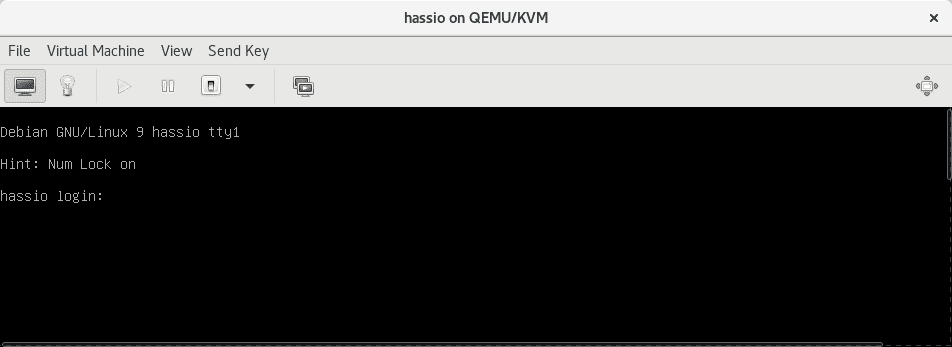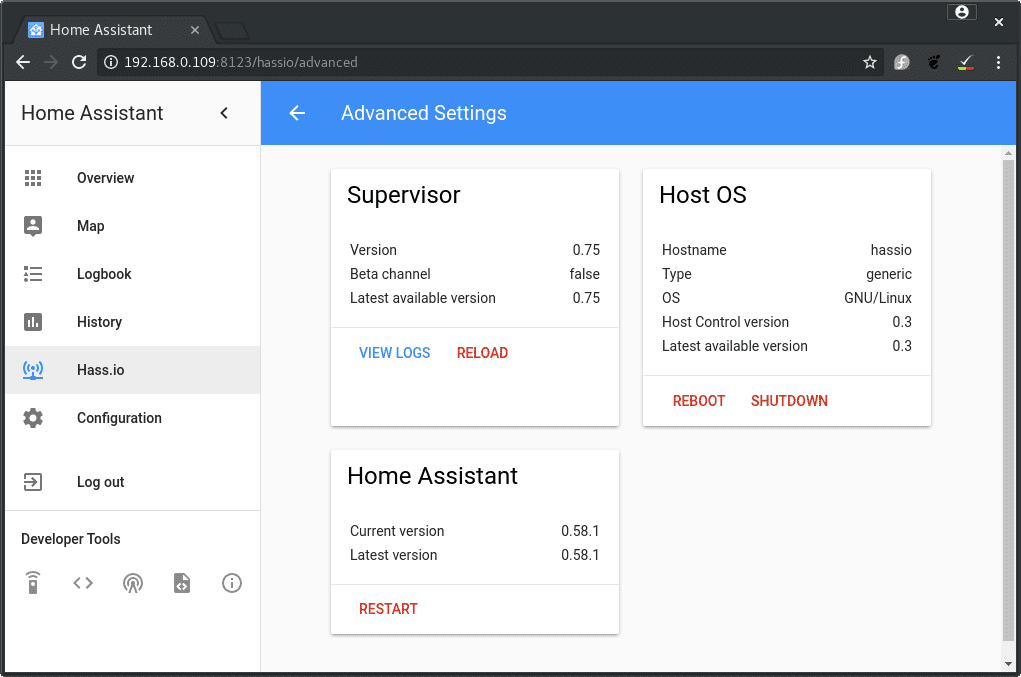Set up Hass.io on top of a virtual machine
The images for the Raspberry Pi family and the Intel NUC are an easy way to get started with Hass.io. For a test or if you have a system which is already hosting virtual machines then the Hass.io installer is an option to use Hass.io in a virtualized environment. In this guide the host is a Fedora 27 system with libvirt
Assuming that you already have setup libvirtd. You might need to install virt-builder and virt-viewer additionally.
sudo dnf -y install libguestfs-tools-c virt-install virt-viewer
We will create a virtual machine with Debian 9 and a 10 GB disk image in the QCOW format. Use $ virt-builder --list to get an overview about what’s operating systems are available if you prefer to use a different system.
$ sudo virt-builder debian-9 \
--output /var/lib/libvirt/images/hassio.img \
--format qcow2 \
--size 10G \
--root-password password:test123 \
--hostname hassio \
--firstboot-command "dpkg-reconfigure openssh-server"
[...]
[ 147.6] Finishing off
Output file: /var/lib/libvirt/images/hassio.img
Output size: 10.0G
Output format: qcow2
Total usable space: 9.3G
Free space: 8.1G (87%)
Now, we are making our new virtual machine available for libvirtd. If you get an error that the OS is unknown, use $ osinfo-query os to get the name to use with --os-variant. To access the virtual machine is connected to the bridge bridge0.
$ sudo virt-install --name hassio --import --ram 1024 \
--os-variant debian9 -w bridge=bridge0 \
--autostart --disk /var/lib/libvirt/images/hassio.img
 Hass.io virtual machine in Virtual Machine Manager
Hass.io virtual machine in Virtual Machine Manager
Depending on your preferences you can use the Virtual Machine Manager (virt-manager) or virsh to manage the created virtual machine. Log in and create an user with # useradd ha and set a password with # passwd ha. We will need that user to make a SSH connection to the virtual machine.
Log in as ha with the given password. If your are using the default network of libvirtd then the DHCP range is defined in /var/lib/libvirt/dnsmasq/default.conf. In this guide the virtual machine is present at 192.168.0.109.
$ ssh [email protected]
[email protected]'s password:
Linux hassio 4.9.0-3-amd64 #1 SMP Debian 4.9.30-2+deb9u3 (2017-08-06) x86_64
[...]
$
Install the requirements after you switch the user to root.
$ su
Password:
root@hassio:/home/ha#
root@hassio:/home/ha# apt-get update
root@hassio:/home/ha# apt-get install bash socat jq curl avahi-daemon \
apt-transport-https ca-certificates
We want the latest Docker release. This requires additional steps to set it up as unlike other distributions Debian is lacking behind with current packages.
root@hassio:/home/ha# wget https://download.docker.com/linux/debian/gpg
root@hassio:/home/ha# apt-key add gpg
OK
root@hassio:/home/ha# echo "deb [arch=amd64] https://download.docker.com/linux/debian $(lsb_release -cs) stable" | tee -a /etc/apt/sources.list.d/docker.list
root@hassio:/home/ha# apt-get update
Now, it’s possible to install a current release of Docker
root@hassio:/home/ha# apt-get -y install docker-ce
Start docker and enable it.
root@hassio:/home/ha# systemctl start docker && systemctl enable docker
An installation script
root@hassio:/home/ha# curl -sL https://raw.githubusercontent.com/home-assistant/hassio-build/master/install/hassio_install | bash -
[INFO] Install supervisor docker
[INFO] Install generic HostControl
[INFO] Install startup scripts
[INFO] Init systemd
Created symlink /etc/systemd/system/multi-user.target.wants/hassio-supervisor.service → /etc/systemd/system/hassio-supervisor.service.
[INFO] Start services
If it’s done, then there will be two new containers.
root@hassio:/home/ha# docker ps
CONTAINER ID IMAGE COMMAND CREATED STATUS PORTS NAMES
ada5bbfc74f0 homeassistant/qemux86-64-homeassistant "/usr/bin/entry.sh..." 4 minutes ago Up 4 minutes homeassistant
5954ac452ffc homeassistant/amd64-hassio-supervisor "/usr/bin/entry.sh..." 7 minutes ago Up 7 minutes hassio_supervisor
After a connection to the container which is containing Home Assistant is made, you will see the log output.
root@hassio:/home/ha# docker attach --sig-proxy=false ada5bbfc74f0
2017-11-28 19:24:30 INFO (MainThread) [homeassistant.core] Bus:Handling <Event state_changed[L]: entity_id=sun.sun, old_state=<state sun.sun=below_horizon; next_dawn=2017-11-29T06:17:58+00:00,...
For further details about the container, inspect can help.
root@hassio:/home/ha# docker inspect bb32b525d1ad
[...]
"OnBuild": null,
"Labels": {
"io.hass.arch": "amd64",
"io.hass.machine": "qemux86-64",
"io.hass.type": "homeassistant",
"io.hass.version": "0.58.1"
}
[...]
Hass.io is now ready. The frontend is available at http://192.168.0.109:8123
 Hass.io overview
Hass.io overview
Keep in mind that there are limitations with this approach. Not all add-ons will work and some don’t make sense to use as the hardware is not present. E.g., use the SSH community add-on